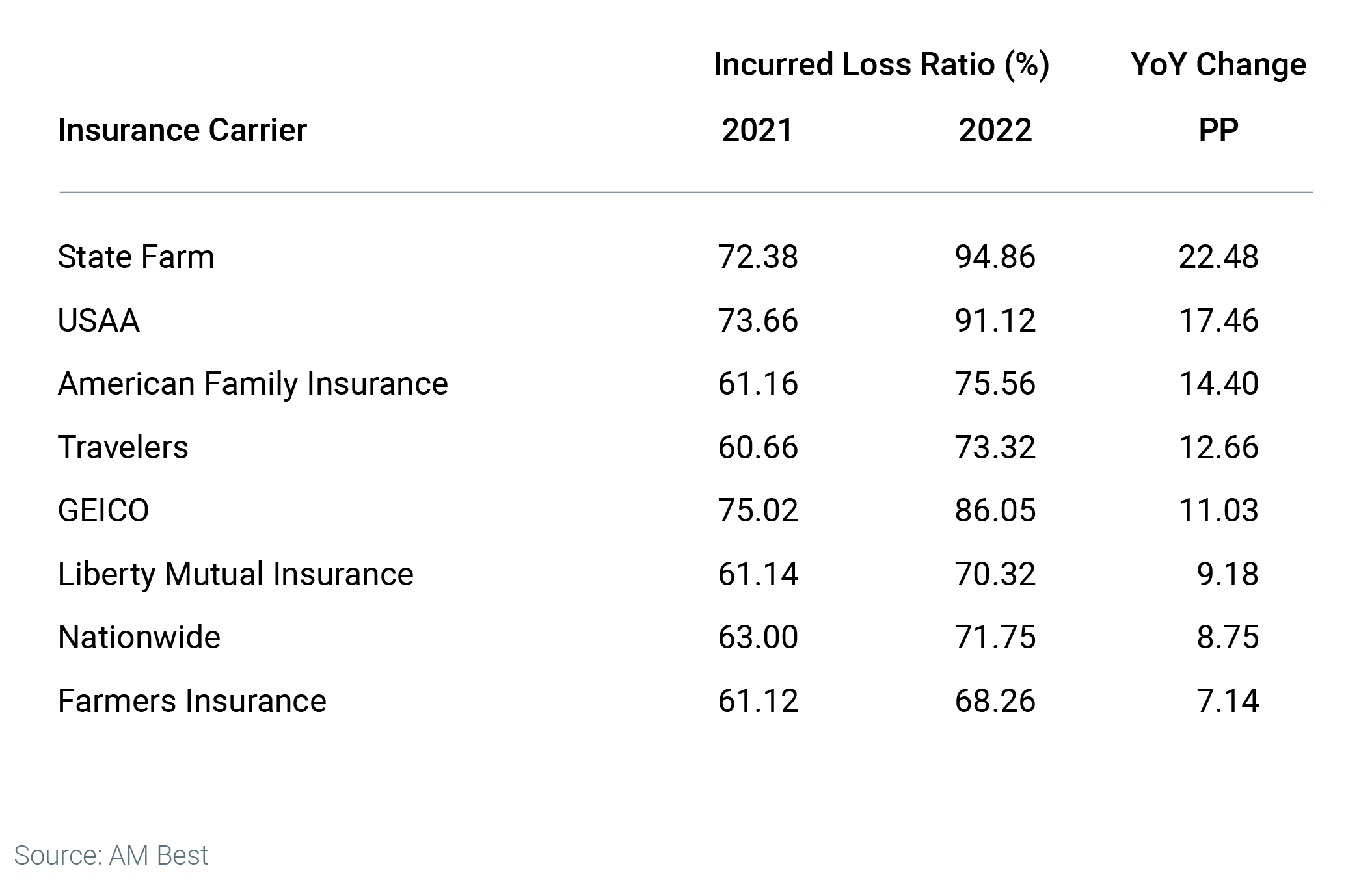Protecting drivers: Auto insurance and the future of mobility Read article


By almost every metric, 2022 was an incredibly challenging year for personal lines auto insurers in the U.S. The biggest insurance carriers reported a higher incurred loss ratio year over year, driven by a number of factors that had a negative financial impact.


Coupled with other unexpected outcomes, such as supply chain issues affecting availability of replacement vehicles and “zero repairability” of certain electric vehicles, insurance carriers were faced with skyrocketing claims costs and were forced to increase insurance premiums to balance their loss ratios.
Consumers, especially ones who hadn’t experienced a recent accident or who were facing their own financial struggles, were understandably frustrated by these rising costs and responded by shopping around for more competitive rates. In fact, auto insurance shopping has been at an all-time high the past two years, with an increase in the rate of switching in Q4 of last year.
While carriers may feel like they’re being bombarded from all sides, it’s worth remembering that challenges also present new revenue opportunities. Sun Tzu’s “The Art of War” has taught us that “in the midst of chaos, there is also opportunity.” Heading into 2023, carriers have a unique opportunity to drive profitability. They can retain their best customers and attract new, profitable prospects – while ensuring they’re pricing appropriately to account for recent increases in accident frequency and severity as well as other rising costs.
Telematics is an appealing solution for carriers who are already facing the impact of economic challenges that have resulted in rising loss ratios.
Usage based auto insurance (UBI) programs have been around in the U.S. for over two decades, but telematics data is still underutilized by nearly every insurer. Unlike traditional pricing, which relies on data like personal characteristics, credit score, and claims history, telematics doesn’t rely on proxy variables to predict the likelihood of loss. It’s far more accurate because it uses actual driving behavior.
For insurance carriers who are considering which telematics solution to implement, there are three criteria to consider:
With a traditional telematics program, a common hurdle for all insurance carriers is the implementation cost and initial time investment required. With complexities like app integrations, agent training, and IT dependencies, it takes months to even begin to implement a solution, not to mention the rate filings state by state. The set-up plus the ongoing support is a sizable operating expense for any insurance carrier. For long-term success with traditional telematics, substantial upfront investment and unwavering long-term commitment are required.
It takes time for a new traditional telematics program to gain traction with agents, let alone policy holders. Even when customers are offered significant savings, there are several reasons why they might choose not to enroll, from concerns about how large their discount will be to sheer laziness in downloading an app. Despite this, more and more consumers are expected to opt into telematics in years to come. Nevertheless, even if you can get consumers to opt in, it takes time to gather sufficient data and draw meaningful conclusions.
Telematics has been through several iterations of data collection methods, first with devices installed into vehicles such as onboard diagnostics (OBD-II), then mobile apps, and now the vehicle itself via connected car.
But Arity thinks beyond the data that can be gleaned from the driver or vehicle and has begun incorporating additional data types to provide meaningful contextual information. For example, driving 50 mph on a street with a posted speed limit of 45 mph is acceptable, however, it’s reckless in a 25 mph school zone during the morning drop-off hours. Therefore, Arity captures additional context such as speed limit and bad weather. Furthermore, Arity has incorporated historical claims data to help carriers not only assess overall risk but, more specifically, the impact on loss cost across each coverage.
From its inception in 2016, Arity aims to make transportation smarter, safer, and more useful for everyone. To achieve this goal, Arity has been collecting and analyzing driving behavior data from a variety of sources to create a deeper understanding of how people move. To date, Arity has achieved the following industry-leading distinctions:
With industry-leading privacy practices by Arity, those who have opted in to share their driving data with us can rest assured knowing their information is being carefully protected with the same care as credit and other sensitive information.
Regardless of your level of expertise with telematics, Arity has a full suite of solutions along with dedicated technical experts to enable any insurance carriers to identify and quantify risky driving behavior. From our off-the-shelf insurance telematics solution Routely® that can also be custom-branded to our driving engine SDK that can be embedded in your flagship mobile app to capture driving behavior in real time.
However, our latest innovation, Arity IQ℠, is a game changer – a real-time risk assessment tool that exceeds all the listed considerations: It’s quick to implement, it’s quick for customers to adopt, and it gives carriers instant access to actual driving risk data on tens of millions of U.S. drivers at time of quote. With it, you can leverage telematics data at scale to improve the sophistication of your pricing model and, most importantly, improve profitability and grow your business.
Telematics is an appealing solution for carriers who are already facing the impact of economic challenges that have resulted in rising loss ratios. It provides an accurate picture of actual driving behavior, enabling carriers to achieve better pricing sophistication and improved retention, growth, and profitability.
No matter where you are in your telematics journey, Arity offers the right solution to meet your specific needs. And with our full suite of solutions, Arity can help bring the power of telematics to bear across your entire organization – from marketing to pricing to strategic planning and beyond. Contact us to learn more.